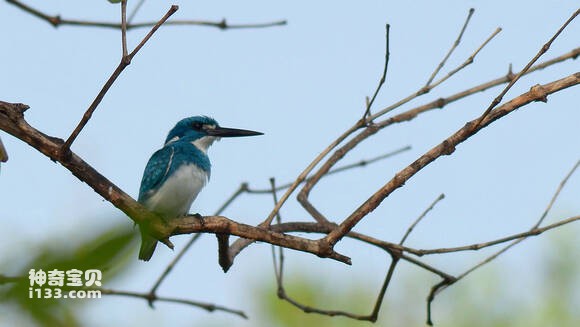Alcedo coerulescens
IUCN
LCBasic Information
Scientific classification
- name:Alcedo coerulescens
- Scientific Name:Alcedo coerulescens,Small Blue Kingfisher,Cerulean kingfisher
- Outline:Climbing birds
- Family:
Vital signs
- length:About 13 cm
- Weight:12-18g
- lifetime:No textual research information is available
Feature
The head and upper parts of the male are Marine blue
Distribution and Habitat
The little Blue kingfisher is found in Sumatra, Java, Kangaan Islands, Bali, Lombok, Sumbawa and other islands in Indonesia.
The little blue kingfisher is found in rivers, canals, reservoirs, wetlands, estuaries, lakes, vast mud, mangroves, fish ponds and irrigated rice fields. Its habitat ranges from sea level to 800 meters.
Appearance
The little Blue kingfisher is a small kingfisher with a body length of 13 cm and a weight of 12-18 g. The head and upper parts of the male are Marine blue. The lateral neck and upper beak base of the bird have white spots. The tail is a bright silver-blue hue. The body is white, and the chest is interspersed with blue broadband. The mouth is black, the irises are dark brown, and the legs and feet are reddish brown. The underside of the wings is white. The female is different, the body feathers are green. The underbody of the young bird is grayish white. Hardly any chest straps. [1]
Mouth thick straight, long and firm, mouth ridge round; No nasal furrow; The wingtip is long, the first primary feathers are slightly shorter, and the third and fourth feathers are longest; Tail short round; The body feathers are showy and luminous, often blue or green. The head is large, the neck is short, the wings are short and round, and the tail is mostly short; The mouth is long and pointed, the ros
Details
Alcedo coerulescens, or Small Blue Kingfisher or Cerulean kingfisher, is a small kingfisher.

Small blue kingfisher usually lives alone on the branches or rocks near the water, waiting for the opportunity to hunt, mainly to eat small fish, and eat crustaceans and a variety of aquatic insects and larvae, but also pecking at small frogs and a small number of aquatic plants. When a kingfisher plunges into the water, it can also maintain excellent vision because its eyes can quickly adjust the contrast in the Angle of view caused by the light in the water. So the fishing ability is very strong.

The breeding season of the little blue kingfisher is from April to June, and in some places it extends to August to October. Nests are built on earth cliffs, or in the banks of fields and streams, in burrows dug with their mouths, usually without bedding. The eggs are laid directly on the nest ground. Each clutch lays 3-6 eggs. Egg color pure white, bright, slightly spotted, about 28 mm ×18 mm in size, 1-2 broods per year; The incubation period is about 21 days, and the eggs are incubated by both sexes, but only fed by the female.
Listed on the International Union for Conservation of Nature (IUCN) 2013 Red List of Threatened Species ver 3.1 - Low Risk (LC).
Protect wild animals and eliminate wild meat.
Maintaining ecological balance is everyone's responsibility!








